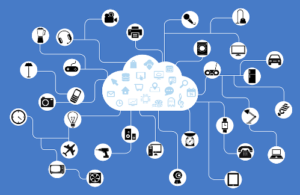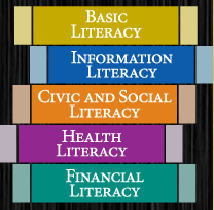If you’re wondering what the “Internet of things” (IoT) means, don’t fret! You probably already know about this concept if you’re aware of connected devices or “smart” devices like Fitbits or even smartphones. The article Libraries and the Internet of Things offers a clear definition of this concept: “The simplest definition of the Internet of Things (IoT) might be: real-world objects connected to the Internet, sending and receiving data.” These devices can communicate with each other, with people, and collect and even interpret data, using cloud-based computing. As this Forbes article, A Simple Explanation Of ‘The Internet Of Things explains, “The IoT is a giant network of connected ‘things’ (which also includes people).” This concept has and continues to be the subject of much discussion in both the worlds of technology and libraries. The OCLC Symposium even featured a keynote from Daniel Obodovski, author of The Silent Intelligence: The Internet of Things at the 2014 ALA Annual Conference in Las Vegas, where he described the history and major issues regarding IoT.
Devices like Fitbits send fitness data to the user’s computer, “smart” baby monitors send information about a baby’s breathing to the parent’s smartphone- the list of internet-connected things grows each day. The use of such connected devices is now a common feature of every aspect of modern life, from home automation or smart home devices that allow consumers to control aspects like lighting and HVAC systems from afar, to smart cars that can help drivers avoid accidents by  deploying the brakes in emergency situations. “Smart cities”, where towns or cities can gather and analyze information about traffic congestion, use smart sensors throughout their locale. The city of Amsterdam even holds an annual Amsterdam Smart City Challenge, where residents can submit ideas that meet the city’s goals of reducing traffic, increasing safety, and conserving energy. For example, a resident developed an app, Mobypark, which allows people to rent out their parking spots, and in turn provides the city with valuable information about parking demand and traffic flow.
deploying the brakes in emergency situations. “Smart cities”, where towns or cities can gather and analyze information about traffic congestion, use smart sensors throughout their locale. The city of Amsterdam even holds an annual Amsterdam Smart City Challenge, where residents can submit ideas that meet the city’s goals of reducing traffic, increasing safety, and conserving energy. For example, a resident developed an app, Mobypark, which allows people to rent out their parking spots, and in turn provides the city with valuable information about parking demand and traffic flow.
But what does this have to do with libraries, you might be asking yourself? It’s an important question, echoed by an OCLC article Libraries and the Internet of Things: “will connected objects—clothes, cars, plants, utilities, factories, homes, buildings—fundamentally change the way libraries serve their users?” According to Business Insider, there were 10 billion devices connected to the internet in 2015, and they project an increase to 34 billion by 2020. The sheer number of devices will certainly affect library services, due to their increasing ubiquity. On several levels, the IoT already has and will continue to affect libraries and their services- t hrough building and grounds care, collections management, related programming and instruction, and consideration of data security concerns.
hrough building and grounds care, collections management, related programming and instruction, and consideration of data security concerns.
Many libraries already use RFID chips to track their collections, an example of an existing use of IoT technology. In addition to tracking collections, smart devices can help libraries manage environmental controls, like thermostats and lights. North Carolina University’s Hunt Library has even employed a bookBot, a robotic book delivery system, that allows students to access any of the two million items held in climate-controlled storage with a click on the catalog. The space-saving shelving (which uses 1/9 of the space of traditional shelving) allowed the library to offer many more learning and meeting spaces for their patrons. While some have expressed understandable concern that smart technology and automation is rendering some jobs obsolete, I believe that smart systems can also allow library staff more time to devote to tasks and projects that require human ingenuity. As Gwyneth Jones, creator of the Daring Librarian blog so perfectly explained in her post about using the Amazon Echo in her library: “only a librarian can give the necessary context to any information, be able to sift through the results like a surgeon, curate the best, and give all that to the student or patron with a smile.”
Libraries can also serve as resources for their patrons using consumer-focused smart devices through explicit instruction, curated online resources, and one-on-one help. Libraries will (or perhaps already do!) almost certainly play a part in the information literacy aspect of this concept. In addition to lending items and offering programming related to the use of such devices, libraries can also inform their patronage about inherent security risks. USA Today described how the government has started to educate their own members about such risks. In 2015, two members of Congress — Reps. Darrell Issa, R-Calif., and Suzan DelBene, D-Wash formed a caucus: “Congressional Caucus on the Internet of Things” to help members of Congress learn about such quickly developing technology. Additionally, four senators spurred on the Senate’s first-ever hearing on the topic, The Connected World: Examining the Internet of Things, presented before the Senate Commerce, Science and Transportation Committee, as a means to discuss this growing industry and to simultaneously educate politicians: “as more Americans connect to the Internet through everything from fitness bracelets to coffee makers, Congress is looking at ways to spur innovation while ensuring that hackers don’t exploit the growing number of smart gadgets to steal personal data.” This leads to another way libraries can help their patrons learn about the IoT, especially those concerned about protecting the privacy of the information collected by such items: by offering the opportunity to try smart devices themselves through lending programs.
Through the lending process, libraries have a built-in opportunity to educate their patrons about smart “things”, by giving the patrons instructions, tips, and details of the device’s capabilities when they check out. Many libraries already lend non-traditional items like “Kill a Watt” meters, baking pans, fishing gear, biking supplies, museum passes, and mobile hotspots- why not smart devices like a Fitbit or Amazon Echo, too? In fact, many already do lend such items! The Stuffbrary of the Mesa Public Library in Arizona (and many other libraries, too) already lets patrons borrow Fitbits and blood pressure machines. Many libraries have already received free indoor air quality monitors through the National Speck Library Program, where the makers of the Speck Air Quality Monitors provide three, free of charge, as long as libraries pledge to circulate them to their patrons at no cost. Many kinds of items could be lent by libraries: like smart plugs, smart speakers, streaming devices like Google Chromecast, or even audio-recording wristbands and smart jump ropes! Libraries can even designate certain devices for in-house use, to give everyone the opportunity to test new technology.
Gwyneth Jones, author of the blog mentioned above, wrote in her post There’s an Echo in My Library! about how she’s using the Amazon Echo and Alexa in her school library. She found that the device helps her students in a variety of ways: learning how to phrase questions correctly, practicing speaking clearly, and finding answers to questions.
In the future, the  possibilities enabled by the IoT could lead to dramatic changes in library service. Obodovski explained how library cards could collect and use information about the patron to offer new reading, watching, or listening suggestions, or even notify the patron about an upcoming library event that may interest them based on their previous attendance or information they provide about their interests. While researching for this article, I came across a Reddit thread where people discussed how the Amazon Echo could be linked to their library and used to access public library information related to their account. One thread participant even linked to Amazon’s instructions for accomplishing such a connection. Many libraries already offer their patrons the option to turn on their lending history. Suggesting new materials based on this information seems like a logical next step that many patrons may already expect, based on their experiences with websites like Amazon and Goodreads.
possibilities enabled by the IoT could lead to dramatic changes in library service. Obodovski explained how library cards could collect and use information about the patron to offer new reading, watching, or listening suggestions, or even notify the patron about an upcoming library event that may interest them based on their previous attendance or information they provide about their interests. While researching for this article, I came across a Reddit thread where people discussed how the Amazon Echo could be linked to their library and used to access public library information related to their account. One thread participant even linked to Amazon’s instructions for accomplishing such a connection. Many libraries already offer their patrons the option to turn on their lending history. Suggesting new materials based on this information seems like a logical next step that many patrons may already expect, based on their experiences with websites like Amazon and Goodreads.
Clearly, the collection of such data using smart devices brings up major privacy concerns and may challenge the ethics of the public library in regards to privacy and confidentiality. In general, the security of smart devices represents a huge concern, succinctly described in the article What Is The Internet Of Things & How Will It Affect Our Future: “device-to-device communication is all good and dandy until a human decides to spoof part of that connection and remotely hijack a device for malicious purposes.” As librarians, we know the value and utter necessity of responsible data stewardship and our enduring work to safeguard the privacy of our customers. In this vein, we can serve as educators to the public regarding the safety of the data collected by smart devices, and as advocates for more stringent regulations and policies governing the collection, storage, and use of such data, few of which exist at this point. Finally, we can ardently support security measures to protect the data of those who use smart devices, by educating the consumers themselves of risks and potential protections.
As more and more connected devices that relate to the concept of the IoT become indispensable features of modern life for many, the importance of understanding the capabilities, uses, and even risks of these items grows as well. Libraries often serve their communities as translators of new information concepts and technology. The library can continue to support the development of information literacy for the public by providing resources to help them understand the idea of the IoT, by lending smart devices and by providing instructions for use. Libraries can also publicize the security risks and best practices for protecting personal data. On a larger scale, libraries can join the movement to push for stringent rules and regulations related to the storage, use, and vulnerabilities of personal data collected by these inter-connected devices.
 Read more about the articles and information referenced above:
Read more about the articles and information referenced above:
The Internet of Things Will Thrive by 2025
How to keep hackers out of your smart devices
Libraries and the Internet of Things
Congress sees security risk in ‘Internet of Things
Exploring the Internet of Just About Everything
The Internet of Things Is Far Bigger Than Anyone Realizes
How libraries can save the Internet of Things from the Web’s centralized fate
Libraries and the ‘Internet of Things
What Is The Internet Of Things & How Will It Affect Our Future
https://amsterdamsmartcity.com/projects
For more ideas on how to promote Information Literacy in your library, visit the PA Forward Commons and be sure to add your programs to the database by completing the PA Forward Commons Submission Form!


